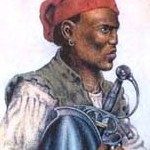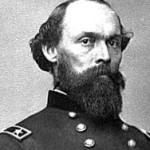Documenting The History Of Mob Violence Against African-American Veterans
Image, above: A black airman from New York City reads the “Colored Waiting Room” sign in the segregated Terminal Station in Atlanta, Georgia, 1956.. (Bettman/Getty Images.)
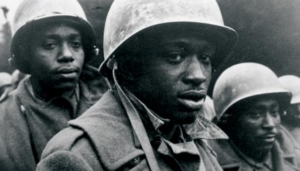 (NPR) In Montgomery, Ala., earlier this year, social justice advocates unveiled a memorial to thousands of African-Americans murdered by lynch mobs. And the activists discovered something that many people didn’t know. The prime targets for lynchings have included military veterans, men who served their country and then came home. Here’s Jay Price of member station WUNC.
(NPR) In Montgomery, Ala., earlier this year, social justice advocates unveiled a memorial to thousands of African-Americans murdered by lynch mobs. And the activists discovered something that many people didn’t know. The prime targets for lynchings have included military veterans, men who served their country and then came home. Here’s Jay Price of member station WUNC.
JAY PRICE, BYLINE: Sometimes it took almost nothing to trigger the violence against black veterans – disagreeing with a gas station attendant or a bus driver – or simply laughing, like 19-year-old Army veteran J.C. Farmer did while clowning around with a friend at a bus stop in Sims, N.C., in 1946. A police officer took offense. They argued. And within hours, a mob shot Farmer dead.
BRYAN STEVENSON: The military has always enjoyed a kind of deference and respect and honor. And it was hard to navigate that for white Southerners when they were dealing with black veterans coming back home.
PRICE: New York University law professor Bryan Stevenson leads the Alabama-based Equal Justice Initiative, which built the National Memorial for Peace and Justice, also known as the lynching memorial. He says black veterans often felt empowered by their military service, especially after World War II when more than a million African-Americans were in uniform.
STEVENSON: Except their wearing the uniform – that was a provocation. And many of them would be asked to take off their uniforms and walk home in their underwear or naked in some optic of humiliation. And they would resist. And there would be conflict, and there’d be violence.
PRICE: Stevenson’s organization has documented the lynchings, defined as extrajudicial killings by mobs, of more than 4,400 African-Americans between 1877 and 1950. The number of veterans is unknown. But Stevenson says thousands were assaulted and many were lynched. (more, including audio)
Related: Lynching in America: Targeting Black Veterans
G.W. Jackson High School Bears
Corsicana ISD honors 1968 PVIL football state champions
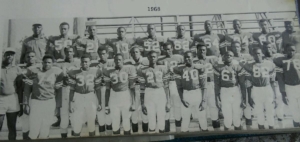 The Corsicana Independent School District recently honored the 1968 G.W. Jackson Bears high school football team on the 50th anniversary of their state championship, the last of seven football state title teams for the school. The players were presented with championship rings at halftime of the game between Corsicana and Forney on Oct. 26 at Tiger Stadium.
The Corsicana Independent School District recently honored the 1968 G.W. Jackson Bears high school football team on the 50th anniversary of their state championship, the last of seven football state title teams for the school. The players were presented with championship rings at halftime of the game between Corsicana and Forney on Oct. 26 at Tiger Stadium.
Jackson, which competed in the Prairie View Interscholastic League, the governing body for black high school teams during segregation, finished the 1968 season with a 10-0 record after defeating Gladewater Weldon, 31-6, for the PVIL 3-A title. The team was coached by Alex Williams.
“The 1968 team holds a special place in Corsicana history as the last state championship
team from G.W. Jackson,” said Dr. Diane Frost, superintendent of Corsicana ISD. “We want
to honor and recognize these men.”
Athletic Director Richey Cutrer and Frost led the effort to commemorate the team. Team members traveled from as far away as Memphis to attend the ceremonies.
Prior to the game, the team met for a dinner at the Corsicana Middle School.
“It has been a pleasure and an honor to visit with these players and coaches and understand the significance of this team winning the state championship title,” said Cutrer.
Jackson High School opened in 1923 and was the high school for Corsicana’s African-American students from 1923-1970. The original school, Fred Douglas, opened in 1882 under the leadership of Mr. G.W. Jackson. Legendary head coach Walter Day guided the Bears to three PVIL titles — 1953, 1956, 1957. However, the program also claimed state championships in 1927, 1928, and 1929. Because of integration, Jackson High School closed in 1970.
(Watch video of halftime ceremony)
The Texas Senate race is not “historic”
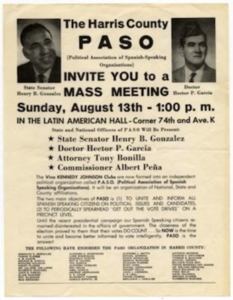 (Los Angeles Review of Books) While Texas still seems red as ever — Hillary Clinton lost the state to Donald Trump by more than 800,000 votes — demographic changes and political transformations on the ground have already created a blue numerical majority. The people are there; all that is needed is for them to organize. Democratic Party leaders now must turn it into a successful effort to seize political power. This is but the latest chapter in a much longer history of community organizing, coalition building, and organically radical politics — a decades-long war against the cowboy conservatism espoused by Texas boosters and politicians.
(Los Angeles Review of Books) While Texas still seems red as ever — Hillary Clinton lost the state to Donald Trump by more than 800,000 votes — demographic changes and political transformations on the ground have already created a blue numerical majority. The people are there; all that is needed is for them to organize. Democratic Party leaders now must turn it into a successful effort to seize political power. This is but the latest chapter in a much longer history of community organizing, coalition building, and organically radical politics — a decades-long war against the cowboy conservatism espoused by Texas boosters and politicians.
In the mid-1960s, despite facing opposition from Texan President Lyndon B. Johnson, four groups — African Americans, Mexican Americans, organized labor, and white liberals — came together in a partnership they called, simply, the “Democratic Coalition.” Together, these diverse activists confronted both Jim Crow and his cousin, Juan Crow, connecting vibrant social movements on the ground with the lofty terrain of formal electoral politics. In the streets and at the ballot box, they learned through experience that the more liberal, the more militant, the more committed to civil rights they grew, the more effective they became. They worked together to confront structural racism and to organize and educate first-time voters from unlikely backgrounds. In the end, the Democratic Coalition brought legions of African Americans and Mexican Americans into the political process, and it gave them the tools to remain active citizens. The activists’ united efforts defeated the worst features of Jim Crow and Juan Crow, carried liberals into office, and permanently expanded the state’s electorate, redrawing the map of Texas politics. (more)
TIPHC Bookshelf
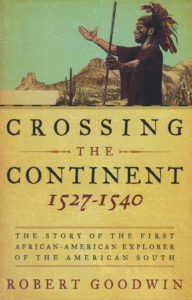 Published scholarship on black history in Texas is growing and we’d like to share with you some suggested readings, both current and past, from some of the preeminent history scholars in Texas and beyond. We invite you to take a look at our bookshelf page – including a featured selection – and check back as the list grows. A different selection will be featured each week. We welcome suggestions and reviews. This week, we offer, “Crossing the Continent, 1527-1540, The Story of the First African-American Explorer of the American South,” by Robert Goodwin.
Published scholarship on black history in Texas is growing and we’d like to share with you some suggested readings, both current and past, from some of the preeminent history scholars in Texas and beyond. We invite you to take a look at our bookshelf page – including a featured selection – and check back as the list grows. A different selection will be featured each week. We welcome suggestions and reviews. This week, we offer, “Crossing the Continent, 1527-1540, The Story of the First African-American Explorer of the American South,” by Robert Goodwin.
The true story of America’s first great explorer and adventurer—an African slave named Esteban Dorantes.
Crossing the Continent takes us on an epic journey from Africa to Europe and America as Dr. Robert Goodwin chronicles the incredible adventures of the African slave Esteban Dorantes (1500-1539), the first pioneer from the Old World to explore the entirety of the American south and the first African-born man to die in North America about whom anything is known. Goodwin’s groundbreaking research in Spanish archives has led to a radical new interpretation of American history—one in which an African slave emerges as the nation’s first great explorer and adventurer.
Nearly three centuries before Lewis and Clark’s epic trek to the Pacific coast, Esteban and three Spanish noblemen survived shipwreck, famine, disease, and Native American hostility to make the first crossing of North America in recorded history. Drawing on contemporary accounts and long-lost records, Goodwin recounts the extraordinary story of Esteban’s sixteenth-century odyssey, which began in Florida and wound through what is now Alabama, Mississippi, Louisiana, Texas, New Mexico, and Arizona, as far as the Gulf of California. Born in Africa and captured at a young age by slave traders, Esteban was serving his owner, a Spanish captain, when their disastrous sea voyage to the New World nearly claimed his life. Eventually, he emerged as the leader of the few survivors of this expedition, guiding them on an extraordinary eight-year march westward to safety.
On the group’s return to the Spanish imperial capital at Mexico City, the viceroy appointed Esteban as the military commander of a religious expedition sent to establish a permanent Spanish route into Arizona and New Mexico. But during this new adventure, as Esteban pushed deeper and deeper into the unknown north, Spaniards far to the south began to hear strange rumors of his death at Zuni Pueblo in New Mexico.
Filled with tales of physical endurance, natural calamities, geographical wonders, strange discoveries, and Esteban’s almost mystical dealings with Native Americans, Crossing the Continent challenges the traditional telling of our nation’s early history, placing an African and his relationship with the Indians he encountered at the heart of a new historical record.
This Week in Texas Black History
Nov 5
On this day in 1901, actress and singer Etta Moten was born in Weimar, Texas. Moten was touted as the “new Negro woman” for her ground-breaking movie roles. She married Claude Barnett, founder of the Associated Negro Press in 1934 the same year, she became first black woman to sing at the White House when she performed for President Franklin D. Roosevelt’s birthday celebration. For the production of “Porgy and Bess,“ Broadway composer George Gershwin wrote the female lead character with Barnett in mind.
Nov 6
On this cold, post-storm morning in 1528, Moroccan Moor servant Esteban (Estevanico) waded ashore near Galveston with a group of shipwrecked Spanish conquistadors and became the first African to set foot in what would become Texas. He and the other survivors would wander for eight years, at times as hostages of Native American tribes, through Texas and along the Rio Grande and into Mexico. Esteban is also considered the first black person to explore Arizona and New Mexico.
Nov 6
Maj. Gen. Gordon Granger was born on this day in 1822 in Joy, Wayne County, New York. As Union commander of the Department of Texas, Granger would arrive at Galveston on June 19, 1865 and deliver General Order No. 3 announcing that slaves in Texas were free, as a result of the Emancipation Proclamation, issued two years earlier. The announcement is the basis for Juneteenth celebrations.
Nov 6
In 1973, on this day, Los Angeles elected its first black mayor, Tom Bradley, a native of Calvert, Texas. The son of sharecroppers and the grandson of slaves, Bradley moved with his family to Los Angeles at age seven. In 1963, after an outstanding career with the Los Angeles Police Department, Bradley became the first African-American elected to the Los Angeles city council. Ten years later, he became the first African-American mayor of a predominantly white city and served an unprecedented five terms. His achievements included securing the 1984 Summer Olympic Games for Los Angeles.
Nov 6
Renowned jazz flutist Hubert Laws was born on this day in 1939 in Houston. Laws played in the marching band at Phillis Wheatley High School in Houston then studied music at Texas Southern University before beginning his professional career playing in Houston jazz groups such as the Crusaders. Has played an recorded with numerous artists including Quincy Jones, Herbie Hancock, Aretha Franklin, Ella Fitzgerald, and Leonard Bernstein and was recipient of the 2011 National Endowment for the Arts Jazz Masters Award and lifetime achievement award from the NEA in the field of jazz.
Nov 6
Wiley College was founded on this day in 1873 and was the first black college west of the Mississippi River. Named in honor of Bishop Isaac T. Wiley, an outstanding minister, medical missionary and educator, the school opened its doors just south of Marshall, Texas with two frame buildings.
Blog: Ron Goodwin, Ph.D., author, PVAMU history professor
Ron Goodwin is an assistant professor of history at Prairie View A&M University. Even though he was a military “brat,” he still considers San Antonio home. Like his father and brother, Ron joined the U.S. Air Force and while enlisted received his undergraduate degree from Texas Lutheran University in Seguin, Texas. After his honorable discharge, he completed graduate degrees from Texas Southern University. Goodwin’s book, Blacks in Houston, is a pictorial history of Houston’s black community. His most recent book, Remembering the Days of Sorrow, examines the institution of slavery in Texas from the perspective of the New Deal’s Slave Narratives.
Recent Posts
Time warp
I’m a big fan of science fiction. I grew up on a daily diet of the original Star Trek series. I watched mesmerized, with my Major Matt Mason action figure in my hand as I watched the moon landing in 1969. One of my favorite science fiction storylines involve time travel. I found just the…(more)
The team
We live in an amazing world. There’s little chance my great grandfather, Big Pappa, could have ever envisioned world-wide communications at the click of a mouse. I’d like to say Big Pappa was a simple man. A country preacher from Gonzales, Texas. But he was so much more. He always told me that my brains…(more)
Submissions wanted
Historians, scholars, students, lend us your…writings. Help us produce the most comprehensive documentation ever undertaken for the African American experience in Texas. We encourage you to contribute items about people, places, events, issues, politics/legislation, sports, entertainment, religion, etc., as general entries or essays. Our documentation is wide-ranging and diverse, and you may research and write about the subject of your interest or, to start, please consult our list of suggested biographical entries and see submission guidelines. However, all topics must be approved by TIPHC editors before beginning your research/writing.
We welcome your questions or comments. Please contact Michael Hurd, Director of TIPHC, at mdhurd@pvamu.edu.


